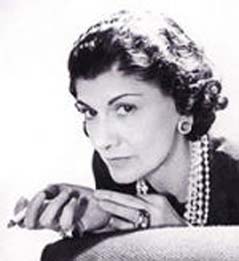Coco Chanel
Gabrielle Bonheur “Coco” Chanel (19 August 1883 – 10 January 1971) was a France fashion designer whose modernist  philosophy, menswear-inspired fashions, and pursuit of expensive simplicity made her an important figure in 20th-century fashion. Replacing the Corset with comfort and casual elegance, her fashion themes included simple suits and dresses, Trousers and Gender Equality, costume jewelry, perfume and textiles.
philosophy, menswear-inspired fashions, and pursuit of expensive simplicity made her an important figure in 20th-century fashion. Replacing the Corset with comfort and casual elegance, her fashion themes included simple suits and dresses, Trousers and Gender Equality, costume jewelry, perfume and textiles.
Early Life
Coco was born in a poorhouse in Saumur, France. The hospice employees were illiterate, so when the mayor François Poitu wrote down the birth, no one knew how to spell Chanel so the mayor improvised and recorded it with an “s”, making it Chasnel. She had five siblings: two sisters and three brothers. In 1895, when she was 12 years old, Chanel’s mother died of tuberculosis and her father left the family a short time later because he needed to work to raise his children. Because of his work, the young Chanel spent seven years in the orphanage of the Roman Catholic monastery of Aubazine, where she learned the trade of a seamstress. School vacations were spent with relatives in the provincial capital, where female relatives taught Coco to sew with more flourish than the nuns at the monastery were able to demonstrate. When Coco turned eighteen, she left the orphanage, and took up work for a local tailor. When Coco was older she searched for her two sisters Lauren and Natalie. They soon met at Paris under the Eiffel Tower.
Fashion Career and Success
She adopted the name Coco during a brief career as a cafe and concert singers 1905-1908. First a mistress of a wealthy military officer then of an English industrialist, she drew on the resources of these patrons in setting up a millinery shop in Paris in 1910, expanding to Deauville and Biarritz. The two men also helped her find customers among women of society, and her simple hats became popular. Soon she was expanding to couture, working in jersey, a material usually associated with men’s underclothes.
By the 1920s, her fashion house had expanded considerably, and her chemise set a fashion trend with its “little boy” look. Her relaxed fashions, short skirts, and casual look were in sharp contrast to the corset fashions popular in the previous decades. Chanel herself dressed in mannish clothes, and adapted these more comfortable fashions which other women also found liberating. She appropriated styles, fabrics and articles of clothing that were worn by men and also appropriated sports clothes as part of the language of fashion
In 1922 Chanel introduced a perfume, Chanel No. 5, which became and remained popular, and remains a profitable product of Chanel’s company. It was the first perfume to be named after a designer.
Fall from Grace
A significant turning point in her life occurred in World War II, when she embarked on a romantic liaison with a German officer, Hans Gunther von Dincklage, whose favours included permission to reside in the Ritz hotel. She had private apartments there for thirty years. She stopped designing, saying that war was not a time for fashion. Her reputation was tarnished by this liaison and she left France for Switzerland in 1945. In 1954, she decided to make a comeback to the world of haute couture. The Chanel suit became instantly popular again and in addition, she introduced bell pottom trousers and pea jackets for women.
She died in 1971 aged 87, in her private suite at the Hôtel Ritz, and she was buried in Lausanne, Switzerland .
See Also
External Links
- Women’s History at Answers.com
- “Madamoiselle Chanel: The Perennially Fashionable”. Chanel. http://um.chanel.com/. Retrieved 2006-10-13.
- Ingrid Sischy (1998-06-08). “Coco Chanel”. TIME 100 – The Most Important People of the Century. http://www.time.com/


